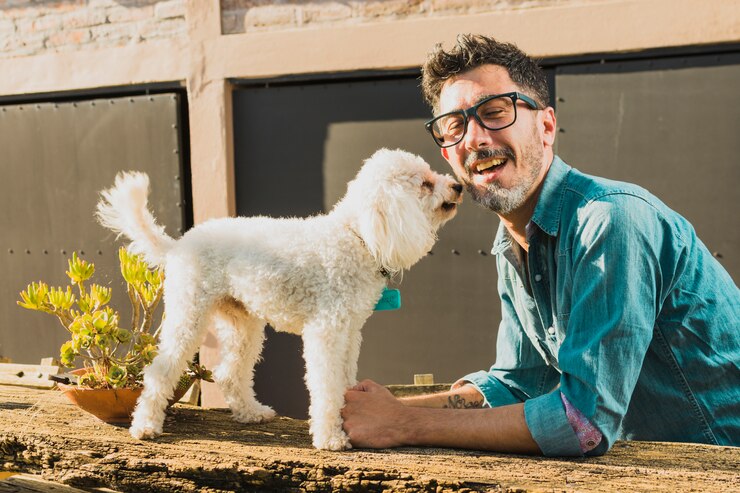
Introduction to Bernedoodles
Bernedoodles are a charming hybrid breed, blending the gentle, loyal nature of the Bernese Mountain Dog with the intelligent, hypoallergenic qualities of the Poodle. This crossbreed has captured the hearts of dog lovers worldwide. Among the various generations, the F1B Bernedoodle stands out for its unique genetic makeup, offering a higher likelihood of a non-shedding coat, making it ideal for allergy sufferers. This article explores the F1B Bernedoodle’s characteristics, care needs, and why it’s a fantastic family pet. Whether you’re a first-time dog owner or a seasoned pet parent, understanding this breed can help you decide if it’s the right fit.
Understanding Bernedoodle Generations
Bernedoodles come in different generations, each defined by their genetic mix of Bernese Mountain Dog and Poodle. These generations influence traits like coat type, shedding, and temperament.
F1 Bernedoodle
An F1 Bernedoodle is a first-generation cross, with 50% Bernese Mountain Dog and 50% Poodle genetics. These dogs often have wavy coats and may shed lightly. Their traits can vary, blending the Bernese’s calm demeanor with the Poodle’s intelligence. They’re a great choice for those seeking a balanced mix but may not be ideal for severe allergy sufferers due to potential shedding.
F1B Bernedoodle
The F1B Bernedoodle, the focus of this guide, results from crossing an F1 Bernedoodle with a Poodle, yielding 75% Poodle and 25% Bernese genetics. This backcross increases the likelihood of a curly, non-shedding coat, making it highly hypoallergenic. F1B Bernedoodles are popular for their predictable coat traits and friendly, trainable nature, ideal for families with allergies.
F2 Bernedoodle
An F2 Bernedoodle comes from breeding two F1 Bernedoodles, resulting in a 50/50 genetic split. However, their traits are less predictable, with coats ranging from wavy to curly and varying shedding levels. This generation is less common due to its variability compared to the F1B.
Other Generations
Other generations, like F2B (F1 crossed with F1B) or F3 (F2 crossed with F2), exist but are less common. These multigenerational crosses can have unpredictable traits, making F1B a preferred choice for consistency in coat and temperament.
The F1B Bernedoodle: In-Depth Look
The F1B Bernedoodle is a standout for its unique blend of traits, particularly its hypoallergenic coat and friendly personality.
Genetics and Appearance
The F1B Bernedoodle’s 75% Poodle genetics significantly influence its appearance and coat. This generation is bred to enhance hypoallergenic qualities, making it a top choice for allergy-prone households.
- Size and Weight: F1B Bernedoodles vary in size based on the Poodle parent. Standard F1B Bernedoodles, from Standard Poodles, weigh 60–90 pounds and stand 23–29 inches tall. Mini F1B Bernedoodles, from Miniature Poodles, weigh 20–45 pounds and stand 18–22 inches. Toy F1B Bernedoodles, from Toy Poodles, weigh under 20 pounds and stand 12–17 inches (PetMD).
- Coat Types and Colors: Their coats are typically curly or wavy, with minimal to no shedding, thanks to the Poodle influence. Colors include black, brown, white, tricolor (black, white, brown), sable, phantom, and merle. These vibrant coat colors add to their appeal (Bluegrass Bernedoodles).
Temperament and Personality
F1B Bernedoodles are known for their intelligence, gentleness, and sociability, making them excellent companions.
- Family-Friendly: These dogs are gentle with children and other pets, forming strong bonds with family members. Their patient nature makes them ideal for households with kids (Jennalee Doodles).
- Intelligence and Trainability: With 75% Poodle genetics, F1B Bernedoodles are highly intelligent and eager to learn. They respond well to positive reinforcement training, excelling in obedience and tricks (Premier Doodles).
- Energy Levels: They have moderate energy, enjoying playtime like fetch or walks but are also content relaxing at home. This balance suits various lifestyles, from active to more sedentary (TryFi).
Caring for Your F1B Bernedoodle
Proper care ensures your F1B Bernedoodle thrives. Their needs include grooming, exercise, training, and health maintenance.
Grooming
The F1B Bernedoodle’s curly or wavy coat requires regular grooming to prevent matting. Brush several times a week with a slicker brush or comb. Professional grooming every 6–8 weeks keeps the coat manageable, especially for longer styles. Shorter clips reduce maintenance. Bathe every 4–6 weeks with dog-specific shampoo, ensuring thorough drying to avoid skin issues. Regular nail trims, teeth brushing, and ear cleaning are essential to maintain overall hygiene (Utah Bernedoodle).
Exercise and Training
F1B Bernedoodles need daily exercise to stay healthy and happy. A mix of walks, playtime, and activities like hiking or swimming works well. They enjoy mental stimulation through puzzle toys or training sessions. Start training early, using positive reinforcement, as their intelligence makes them quick learners. Socialization from a young age ensures they’re well-adjusted around people and pets. Consistency is key to managing their occasional stubbornness (Above and Beyond Standards).
Health Considerations
F1B Bernedoodles are generally healthy but may inherit conditions from their parent breeds. Common issues include hip and elbow dysplasia, progressive retinal atrophy (PRA), von Willebrand’s disease, and bloat. Reputable breeders screen for these conditions, providing health clearances. Regular vet check-ups, a balanced diet, and exercise help maintain health. Their lifespan averages 12–15 years for Standards, 14–16 for Minis, and up to 18 for Toys (PetMD).
Living with an F1B Bernedoodle
F1B Bernedoodles adapt well to various environments but thrive with attention and care.
Family Life
These dogs excel in family settings due to their gentle, patient nature. They bond closely with children, making them great playmates. Supervision is recommended with young kids to ensure safe interactions. Their sociability makes them a joy in active households (Doodles of Oz).
Compatibility with Other Pets
F1B Bernedoodles generally get along with other dogs and cats, especially if socialized early. Proper introductions and gradual exposure ensure harmonious relationships. Their friendly demeanor makes them adaptable to multi-pet homes (Reddit X Post).
Housing and Climate
While adaptable to apartments with sufficient exercise, F1B Bernedoodles prefer homes with yards for play. Their thick coats suit colder climates, but they can live in warmer areas if kept cool and hydrated. They thrive in homes where someone is present often, as they dislike prolonged solitude (Walnut Valley Puppies).
Why Choose an F1B Bernedoodle?
The F1B Bernedoodle’s unique traits make it a top choice for many.
Hypoallergenic Qualities
With 75% Poodle genetics, F1B Bernedoodles are highly likely to have non-shedding, hypoallergenic coats, ideal for allergy sufferers. While not guaranteed for every dog, their coat consistency is a significant advantage (Utah Bernedoodle).
Temperament Advantages
Their blend of Bernese loyalty and Poodle intelligence creates a dog that’s affectionate, trainable, and adaptable. They’re less prone to the variability seen in other generations, offering predictability in behavior and appearance (Jennalee Doodles).
Popularity and Trends
F1B Bernedoodles have surged in popularity due to their hypoallergenic coats and family-friendly nature. Social media showcases their charm, with owners sharing their playful antics. The demand has increased breeder numbers, but choosing reputable ones is crucial. Ethical breeders prioritize health and temperament, ensuring high-quality puppies (Bluegrass Bernedoodles).
(FAQs)
What is the difference between an F1 and an F1B Bernedoodle?
An F1 Bernedoodle is 50% Bernese Mountain Dog and 50% Poodle, while an F1B is 25% Bernese and 75% Poodle, offering a more hypoallergenic coat.
Are F1B Bernedoodles good for families with children?
Yes, their gentle and patient nature makes them excellent family dogs, though supervision with young children is advised.
Do F1B Bernedoodles shed?
Most have minimal to no shedding due to their Poodle genetics, but individual variation exists.
How much exercise does an F1B Bernedoodle need?
They need daily walks and playtime, with amounts varying by age, size, and energy level.
What is the average lifespan of an F1B Bernedoodle?
Standards live 12–15 years, Minis 14–16 years, and Toys up to 18 years with proper care.
Conclusion
The F1B Bernedoodle is a delightful blend of intelligence, loyalty, and hypoallergenic charm, making it an ideal companion for many households. Its predictable coat and friendly temperament cater to allergy sufferers and families alike. With proper grooming, exercise, and health care, these dogs thrive in various environments. If you’re considering an F1B Bernedoodle, research reputable breeders who prioritize health and temperament. Ready to welcome this loving breed into your home? Connect with trusted breeders or rescue organizations to find your perfect furry friend today!



